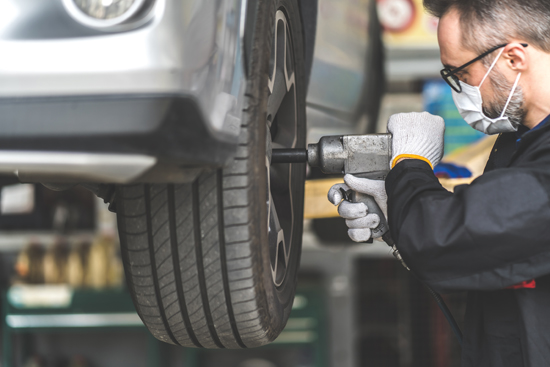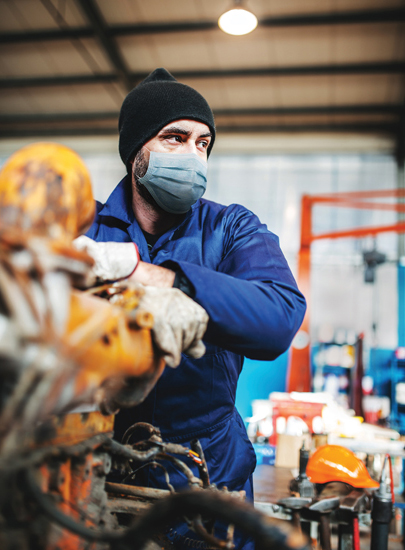
Staying vigilant against COVID-19 at the workplace
May 31, 2021
By
Meagan Gillmore
Safety diligence remains front of mind through pandemic

The COVID-19 pandemic is now into its second year. (navee/Adobe Stock)
As the COVID-19 pandemic continues into its second year, diligence and thoroughness are key to maintaining workplace safety.
“Like everywhere else in the country, a level of fatigue is setting in,” said Al Johnson, head of prevention at WorkSafeBC. “It’s very hard to stay focused on your plans. It’s very hard to stay true to your plans.”
Effective COVID-19 prevention plans need the fundamentals: letting employees work from home when possible; increasing ventilation or installing barriers in the workplace; maintaining physical distancing between employees and practising proper hygiene, said Matthew MacLeod, an occupational health and safety specialist with the Canadian Centre for Occupational Health and Safety in Hamilton, Ont.
Prevention needs to have a “layered approach and implement a combination of control measures,” he said, noting different strategies may need to be implemented.
Safety plans need to consider all areas of the workplace, including places like lunchrooms and breakrooms, said Johnson.
“We’ve asked employers to grow their workplace safety plans to involve those issues that aren’t directly workplace-related, if you will, but they’re an extension of the workplace.”
In lunchrooms, furniture can be removed or rearranged with only a certain number of people allowed in at one time. Doors can be designated for entry and exit.
Supervisors should encourage workers to practise proper physical distancing and hygiene if they take breaks off-site, said Johnson, noting employers need to also consider including guidelines about carpooling in their COVID-prevention plans.
“It’s sometimes more difficult to supervise,” he said about employees’ activity when they’re away from the jobsite.
“Sometimes it’s more about hoping the workers will meet their responsibilities in that regard, once they know what those are, and working together to ensure good COVID safety.”

Workers need to be involved in the creation of COVID-19 safety plans, experts say. (Jacob Lund/Adobe Stock)
Make sure precautions don’t cause risks
Safety measures need to be safe.
“When implementing these controls, you want to make sure that you’re not introducing new hazards,” said MacLeod.
Mistakes could include opening a fire hazard door accidentally in an attempt to increase ventilation, or having workers work alone when they shouldn’t be, he said.
“There’s so many different risks,” said MacLeod. “It really is workplace-specific. When you introduce a new control measure, it needs to be evaluated to ensure that it is effective and there’s no other risks that may be presented.”
And just because COVID-19 is front and centre right now, that doesn’t take away all the requirements under the Occupational Health and Safety Act, said Nicole Hopkins, an account manager with Workplace Safety & Prevention Services in southwestern Ontario.
“You still need to keep up machine guarding, your occupational hygiene, your ergonomics.”
This includes watching for patterns like increased absenteeism that could indicate employees are struggling with mental health, she said.
COVID-19 is a “hazard that is spilling into multiple other hazards,” said Hopkins. “It’s so important right now to be having those conversations with your workers.”
Involve workers in safety before inspectors arrive

It’s been encouraging to see smaller workplaces become highly diligent about health and safety on the job, experts say. (franckreporter/E+/Getty Images)
Workers need to be involved in the creation of COVID-19 safety plans, said Hopkins. Employees may not be able to help make the plans themselves, especially because government information changes quickly, but employers should still discuss the plan with them instead of posting it in the workplace unannounced and with little explanation.
“At the bare minimum, have the conversation with the joint health and safety committee,” she said. “Always be asking for feedback.”
If employees understand the safety plan and what is expected of them, they’ll be more likely to follow through with it, said Hopkins. It will also help during government inspections to ensure compliance with COVID-19 regulations.
“The policies and procedures should be part of their daily work. Having an on-site inspection really should not mean that they do their job any differently,” she said.
In some jurisdictions, like British Columbia, employers and employees don’t know when a worksite inspection for COVID-19 compliance will take place.
In Ontario, the Ministry of Labour, Training and Skills Development does not announce when specific inspections will happen, but will say what sectors the ministry plans to focus on.
“Our provincial officers follow the same approach with COVID-19 inspections as they would for any other inspection,” said Johnson, in B.C. “It truly is an inspection to determine compliance. We want to catch employers doing it right.”
It’s “best practice” to have a written copy of the COVID-19 plan available, in case inspectors ask to see it, said MacLeod. “Employers should have evidence that they’ve trained their workers on the procedures that they are to follow and really monitoring the guidance on their local health authorities because the information on this virus is changing rapidly.”
The inspectors’ job is to make sure workers have a safe working environment, said Hopkins.
“As long as you’re following the policies and procedures that are put in place, you can’t get into trouble as an employee,” she said. “Make sure that you’re wearing your mask and that you’re following the procedures. That’s all you can do.”
“At the end of the day, the inspectors are there to ensure that the employees have a safe working environment. They are the employees’ advocate.”
Including vaccinations in workplace prevention
As vaccination continues, employers need to consider how — or if — they will require employees to be vaccinated against COVID-19.
“Any mandatory vaccination policy should contemplate the fact that there could be valid, legal reasons why an employee cannot or should not be vaccinated,” said Dan Black, a lawyer with Caravel Law in Toronto, who regularly advises workplaces on occupational health and safety matters.
In Black’s view, employers cannot force their employees to get vaccinated — even if there is a mandatory vaccination policy.
They can, however, have consequences for unvaccinated workers, such as restricting the types of work they are allowed to do, or if they’re able to work in-person.
Employers should also check if their jurisdiction’s employment laws allow them to place employees who refuse to get vaccinated, or aren’t vaccinated, on temporary, unpaid leave, he said.
“Before implementing a mandatory vaccination policy, an employer should consider how it will respond if an employee refuses vaccination and the potential legal implications,” Lisa Bolton, a lawyer with Sherrard Kuzz LLP in Toronto, said in an email.
“For example, if an employer terminates an employee’s employment for failing to comply with a mandatory vaccination policy, the employer may be liable for pay in lieu of notice and severance.”
Some staff may have a medical condition or disability that makes vaccines potentially dangerous for them, or may hold religious beliefs that prohibit vaccination. Human rights law states employers cannot discriminate and have a duty to accommodate up to undue hardship.
In these circumstances, employees must provide “evidence reasonable in the circumstance” about why disabilities, medical conditions, or religious beliefs prohibit them from getting vaccinated, said Black, noting employees should have a doctor’s note that explains why the vaccine would harm them, or why they can’t wear a mask because of a disability or medical concern.
Employers have very limited rights to “look behind the note, such as demanding to know the specific medical condition,” he said.
Employees who have religious objections to vaccinations should ask their religious leader — for example the leader of the congregation to which they belong — to write a letter on official letterhead explaining why their beliefs oppose vaccination, said Black.
Throughout the pandemic, some people have said that being forced to wear a mask goes against their freedom of conscience or opinion.
“Conscience rights are a little more difficult to determine,” he said. “However, it’s likely that health and safety law would tend to trump that sort of consideration.”
“Creed” is listed in the Ontario Human Rights Code, but not defined.
“But it hasn’t been found to include anti-masks beliefs or political opinions,” said Bolton.
Promoting health and safety
Workplace safety professionals hope the positive lessons from the pandemic continue after it ends.
It’s been encouraging to see smaller workplaces become highly diligent about health and safety on the job, said Johnson.
“Once COVID-19 safety is under control, it would be nice if they would continue to think about safety,” he said, noting he hopes employers and employees continue to work together to promote health and safety.
“We want employers to continue to engage their workers in safety,” said Johnson. “That’s our hope going forward: that the COVID learnings will continue to be applied on other risks in the workplace.”
Meagan Gillmore is a freelance writer in Toronto.